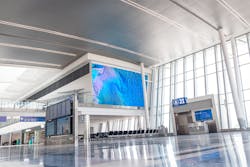More Airports Embrace the Possibilities of Audiovisual Experiences
Folks keep flying. According to the International Air Transport Association, passenger numbers are expected to reach 4.72 billion in 2020, up 4 percent from 4.54 billion in 2019, which was itself a record year. As more people travel, airports around the world are reinventing themselves by using audiovisual (AV) technology as a foundational design element.
Most passengers encounter such AV installations for just moments — as they check in, run to catch a plane, buy souvenirs, grab a bite, or gather their luggage. As an example of these AV experiences, more airports are installing large video walls — sometimes behind airline counters; sometimes in security halls — to help improve the passenger journey and communicate more effectively. In fact, as many airports invest millions in infrastructure, they’re allotting more to AV technology that makes travel more enjoyable, markets a terminal’s vendors, engages the public, brands a city, conveys information, and more.
According to research by AVIXA, the Audiovisual and Integrated Experience Association, transportation hubs are boosting their investment in AV solutions, whether it’s digital signage, video walls, interactive displays, or directional audio. According to AVIXA’s Industry Outlook and Trends Analysis (IOTA) report, the transportation sector spent about $11.5 billion worldwide on AV products and services in 2019. And investment in AV by transportation enterprises worldwide is expected grow almost 8 percent a year through 2023.
Here are some ways airports are making their AV investments count:
AV as a Differentiator
You may have read how Charlotte Douglas International Airport, along with the Charlotte Arts and Science Council, created an intricate digital art feature for its Concourse A that fused technology, art, and design. At the 2019 AAAE Airport Innovation forum, CLT’s Business Intelligence Manager Katie McCoy shed light on the rationale behind the installation.
“We really wanted to focus on passenger experience,” she said. “Happier passengers spend more money.”
The main element of the CLT project is a giant video wall by renowned digital sculptor Refik Anadol. The team originally considered modern projection technology, but after realizing projectors couldn’t compete with Concourse A’s high ambient light levels, it decided on a series of LED displays — the type you might ordinarily see outdoors on digital billboards or at New York’s Times Square.
The primary LED display is 10 feet tall and extends 140 feet along a hallway framed by large windows. Passengers glide past on a moving walkway and data from airport systems, weather feeds, and other local sources combine to create living, swirling, immersive digital artwork along the length of display. The massive digital sculpture is visible through the windows from the curb outside, allowing road traffic to take in the spectacle as well.
“What's the ROI?” McCoy said. “Well, we have been doing passenger satisfaction surveys for 10 years and our net promoter score had dropped significantly. So we dug a little deeper and found that it was millennials who were pulling down that score. [Then] we did a focus group…and they were saying, ‘I want to feel a certain way when I come to your airport. The experience isn't differentiated from any other airport.’”
With new, large-scale AV experiences throughout, that’s changing. McCoy said CLT has seen an increase in net promoter score since the AV installation launched, and she expects to see revenues increase, too.
AV as a Foundational Design Element
At Orlando International Airport, what started as a more traditional video wall installation morphed into a multi-touchpoint experience that stands to influence MCO’s massive, $2 billion South Terminal project, scheduled for completion in 2021.
For more than a year, MCO planned and installed the 700-screen, continuous video wall that currently spans nearly 1,600 feet behind the North Terminal’s main check-in counters. It was designed by MCO’s technology integrator SITA to work seamlessly with other airport operational systems to deliver dynamic wayfinding, along with flight information, destination time and weather, security and gate information. It was also created so individual airlines could reinforce their own brand on-screen while maintaining a uniform look and feel along the entire expanse.
John Newsome, CIO for the Greater Orlando Aviation Authority (GOAA), called the video wall a “digital canvas” for supporting airline and Orlando-area branding. The goal was also to improve customer service through better, more accessible information and entertainment, which led to a pervasive upgrade of the terminal’s other digital signage. In addition to the 700 screens integrated into the video wall, MCO and its partners installed another 500 displays for curbside wayfinding, messaging along the automated people movers, and elsewhere. Though each digital canvas differs in size, location, and content, they are part of one networked system, allowing MCO to deliver flexible, relevant, visual content across the passenger journey, and creating a foundation for future initiatives.
Since the massive video wall went into action, even MCO has used the dynamic nature of a digital canvas to support its content initiatives. For example, it introduced Annie the Astronaut, an animated 3D character who appeared on the video wall and on other wayfinding screens and served as a virtual customer service rep.
As MCO continues building its new South Terminal, designs are in place to push the boundaries of audiovisual experiences. GOAA officials have shown renderings that include large, digital sculptures with curved LED display surfaces and interactive experiences for engaging the traveling public. Architects described one installation called Windows on Orlando that will greet travelers and include large, interactive screens showing live feeds from local beaches and other attractions.
AV as a Visitor Attraction
Indeed, some airport AV installations are created to be attractions in their own right. At Vienna International Airport, officials commissioned an audiovisual experience designed to connect with visitors in new, technologically savvy ways while enhancing their appreciation of air travel.
Part of Vienna Airport’s Visitor World, accessible in Terminal 3, are several audiovisual installations that simulate everything from a bag’s journey through the system, to a virtual view from air traffic control, to the experience in an airplane cockpit. For the cockpit area, the airport and its partners installed laser projectors and a curved screen to create the desired effect in bright, realistic color. Custom content is fed to the projectors from a central server and blended together in a single, unified view.
This year, Vienna Airport is introducing a virtual reality simulator to its Visitor World, reportedly the first of its kind in Austria. The VR experience, dubbed Birdly, takes participants on virtual flights through Jurassic landscapes or New York’s Manhattan. The airport sells tickets to Visitor World, making the installation not only engaging, but also a revenue generator. Vienna Airport said that in the first year of its operation, Visitor World attracted more than 160,000 guests.
Modern Terminals, Modern Experiences
As airport authorities renovate and upgrade terminal facilities with modern restaurants and stores, and as they open up transit areas with floor-to-ceiling windows and even skylights, there is a growing market for bright, big displays that show more than just arrival and departure times and baggage claim locations. Whether it’s electronic artwork along concourses, digital canvasses that serve multiple purposes throughout a terminal, or exhibits that entertain passengers, audiovisual technology has become a critical design element for entertaining travelers with the goal of making airports less stressful and more enjoyable.
Joé Lloyd is the Senior Director of Communications for AVIXA™, the Audiovisual and Integrated Experience Association. AVIXA represents the $231 billion global commercial AV industry and produces InfoComm trade shows around the world. For more information, visit avixa.org/transportationAV.







